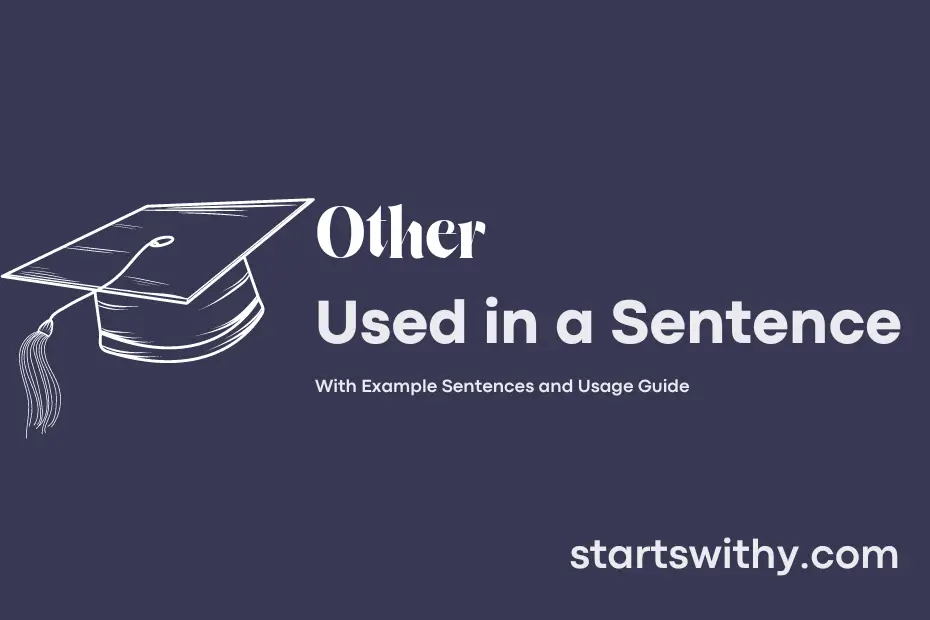Have you ever wondered how to use “other” correctly in a sentence? Often used to refer to an additional or alternative thing, “other” plays a crucial role in defining relationships and making comparisons in English language.
In a sentence, “other” is typically used to indicate that there is a different option, alternative, or category apart from the one being discussed. It helps to provide contrast, emphasize variety, or introduce a distinctive choice among a group of possibilities.
7 Examples Of Other Used In a Sentence For Kids
- I like to play with other toys.
- The red ball is different from the other colors.
- Let’s share the crayons with each other.
- We can help each other during the activity.
- The green apple is sweeter than the other fruit.
- Be kind to each other and be good friends.
- Can you find the other shoe?
14 Sentences with Other Examples
- Other students can join the debate club if they are interested in public speaking.
- Other classmates may want to participate in the upcoming college festival for a chance to showcase their talents.
- The library is a great place to study and interact with other students who are preparing for exams.
- It’s important to respect the opinions and perspectives of other individuals in group discussions.
- Make sure to double-check the assignment deadline to avoid any misunderstandings with other students.
- The college canteen serves a variety of dishes, catering to the preferences of other students.
- Other students have found the study group to be helpful in understanding complex topics.
- Utilize the college’s career center to explore internship opportunities and network with other professionals.
- Don’t hesitate to ask for help or clarification from other classmates during group projects.
- Attend workshops and seminars to expand your knowledge and meet other like-minded students.
- Get involved in clubs and organizations to meet other students with similar interests outside of academics.
- Plan study sessions with other students to brainstorm ideas and share study strategies.
- Use online platforms to collaborate with other students on assignments and projects.
- Consider joining extracurricular activities to develop skills and abilities other than academics.
How To Use Other in Sentences?
Other is a versatile word that can be used in a sentence to refer to something different or additional. Here is a guide on how to use Other effectively:
-
Other can be used as a pronoun to refer to another person or thing that is different from the one already mentioned. For example: “I prefer this blue shirt, but do you have any other colors available?”
-
Other can also be used as an adjective to describe something that is different from the one being referred to. For example: “I have read this book, but I am interested in exploring other genres.”
-
Other can be used in comparative sentences to show a difference between two or more things. For example: “This restaurant is popular, but the other one is less crowded.”
-
Other can be used in phrases like “each other” to indicate a mutual relationship or action between multiple people or things. For example: “The students helped each other with their homework assignments.”
-
Other can also be used to suggest an alternative choice or option. For example: “I don’t like this painting, do you have any other artworks by the same artist?”
By following these guidelines, you can effectively use Other in your sentences to convey different meanings and contexts.
Conclusion
In conclusion, understanding how to connect sentences with other can greatly improve the flow and coherence of your writing. By using transition words and phrases, such as “in addition,” “furthermore,” or “on the other hand,” you can effectively link ideas and create a smooth progression from one point to the next. These connections not only enhance the readability of your text but also help to maintain the reader’s focus and follow the logical structure of your thoughts.
Moreover, by incorporating various ways to connect sentences with other, like using pronouns, conjunctions, or repeating keywords, you can create a cohesive narrative that guides your audience through the different aspects of your writing. Building these connections between sentences not only strengthens your arguments but also ensures that your overall message is clear and easily understood.



